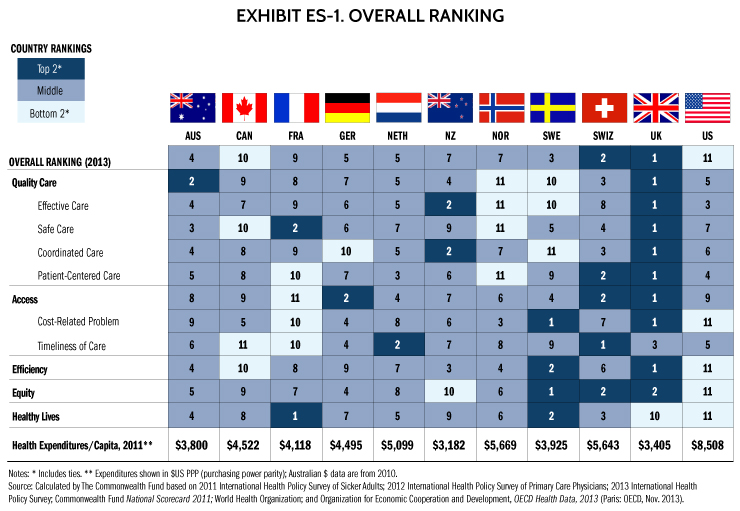New York, NY, June 16, 2014—Despite having the most expensive health care system, the United States ranks last overall among 11 industrialized countries on measures of health system quality, efficiency, access to care, equity, and healthy lives, according to a new Commonwealth Fund report. The other countries included in the study were Australia, Canada, France, Germany, the Netherlands, New Zealand Norway, Sweden Switzerland, and the United Kingdom. While there is room for improvement in every country, the U.S. stands out for having the highest costs and lowest performance—the U.S. spent $8,508 per person on health care in 2011, compared with $3,406 in the United Kingdom, which ranked first overall.
The United States’ ranking is dragged down substantially by deficiencies in access to primary care and inequities and inefficiencies in our health care system according to Mirror, Mirror on the Wall: How the Performance of the U.S. Health Care System Compares Internationally, 2014 Update, by Karen Davis, of the Roger C. Lipitz Center for Integrated Health Care at Johns Hopkins Bloomberg School of Public Health; Kristof Stremikis, of the Pacific Business Group on Health, and Commonwealth Fund researchers Cathy Schoen and David Squires. However, provisions in the Affordable Care Act that have already extended coverage to millions of people in the United States can improve the country’s standing in some areas—particularly access to affordable and timely primary care.

“It is disappointing, but not surprising, that despite our significant investment in health care, the U.S. has continued to lag behind other countries,” said lead author Karen Davis. “With enactment of the Affordable Care Act, however, we have entered a new era in American health care. The U.S. performance on insurance coverage and access to care should begin to improve, particularly for low-income Americans. The Affordable Care Act is also expanding the availability and quality of primary care, which should help all Americans have better care and better health outcomes at lower cost.”
The report was also produced in 2004, 2006, 2007, and 2010, with the U.S. ranking last in each of those years. Four countries were added to this year’s report: Switzerland and Sweden, which followed the U.K. at the top of the rankings, and Norway and France, which were in the middle of the pack. Australia, Germany, the Netherlands, New Zealand, and Norway also placed in the middle, while Canada was just above the U.S. at the bottom.
Key findings related to the U.S. include:
Healthy lives: The U.S. does poorly, ranking last on infant mortality and on deaths that were potentially preventable with timely access to effective health care and second-to-last on healthy life expectancy at age 60.
Access to care: People in the U.S. have the hardest time affording the health care they need. The U.S. ranks last on every measure of cost-related access. More than one-third (37%) of U.S. adults reported forgoing a recommended test, treatment, or follow-up care because of cost.
Health care quality: The U.S ranks in the middle. On two of four measures of quality—effective care and patient-centered care—the U.S. ranks near the top (3rd and 4th of 11 countries, respectively), but it does not perform as well providing safe or coordinated care.
Efficiency: The U.S ranks last, due to low marks on the time and dollars spent dealing with insurance administration, lack of communication among health care providers, and duplicative medical testing. Forty percent of U.S. adults who had visited an emergency room reported they could have been treated by a regular doctor, had one been available. This is more than double the rate of patients in the U.K. (16%).
Equity: The U.S. ranks last. About four of 10 (39%) adults with below-average incomes in the U.S. reported a medical problem but did not visit a doctor in the past year because of costs, compared with less than one of 10 in the U.K., Sweden, Canada, and Norway. There were also large discrepancies between the length of time U.S. adults waited for specialist, emergency, and after-hours care compared with higher-income adults.
“Now that millions more Americans have good coverage, we have to invest in our health care delivery system to be sure all patients—and especially those with the greatest need and whose care is the most costly—can get the high-quality, well-coordinated health care they need,” said Commonwealth Fund President David Blumenthal, M.D. “Those kinds of improvements will go a long way toward improving peoples’ health while making efficient use of our precious health care dollars.”
Methodology
Data are drawn from the Commonwealth Fund 2011 International Health Policy Survey of Sicker Adults; the Commonwealth Fund 2012 International Health Policy Survey of Primary Care Physicians; and the Commonwealth Fund 2013 International Health Policy Survey. The 2011 survey targets a representative sample of “sicker adults,” defined as those who rated their health status as fair or poor, received medical care for a serious chronic illness, serious injury, or disability in the past year, or were hospitalized or underwent surgery in the previous two years. The 2012 survey looks at the experiences of primary care physicians. The 2013 survey focuses on the experiences of nationally representative samples of adults ages 18 and older. Additional data on health outcomes were drawn from the Organization for Economic Cooperation and Development and the World Health Organization.